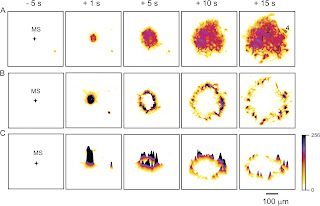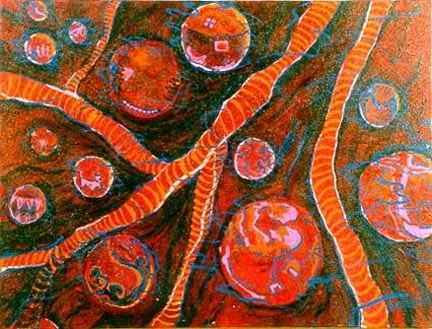
...is calcium. Now, if you were to talk to an average person about calcium, they would talk your arm off about how it strengthens bones and teeth and whatnot. Years and years of propaganda by doctors and Tums commercials have definitely taken their toll on society. However, calcium is not just important for organisms to function as a whole; on the individual cellular level, calcium is crucial for a whole slew of activities. Calcium is a second messenger. Let's say that you have a signaling molecule that cannot pass through the plasma membrane. Oh crap, how do we get the message to the cytoplasm so the cell can respond? Well, that is where second messengers come in quite handy. That hormone will bind to a transmembrane receptor on the extracellular face of the plasma membrane. The response will be transmitted to the protein's intracellular face, which will begin a signal transduction cascade of second and third etc. messengers. In this diagram, calcium is a tertiary messenger, but you get the picture. I trust you.
Here are two of the most common examples of calcium in signaling: Muscle contraction and exocytosis. Let's say....that you decide to kick your friend in the shins because he totally just called your mom a strumpet. Your brain has a hormonal orgy, which results in an electrical signal being sent straight to your leg. The axons of your motor neurons form a gap junction with your muscle. When the signal reaches your motor neurons, acetylcholine is released, causes a depolarization of the muscle fiber membrane, which travels into tubules into the muscle fiber. This action potential causes the sarcoplasmic recticulum to release calcium into the muscle fiber. Calcium binds to troponin, which causes the tropomyosin to move and expose the filament so myosin can attach and cause contraction. I just reviewed BIO 101 for you people. Be grateful.
That is more a physiological role. A cellular role of calcium is in exocytosis. Calcium is necessary for vesicles to fuse with the plasma membrane. They bind to a special SNARE proteins, which allow vesicles to fuse with their specific targets. Each vesicle has a v-snare on its surface that can interact with a specific t-snare on the target membrane. Calcium binds to the v-snare, allowing the two snares to interact, allowing the vesicle to get close enough for vesicle fusion with the  target membrane.
target membrane.
There are also tons of different proteins that require calcium to function. Anything starting in cal- really. Calnexin and calreticulin, which are found in the ER and aid in the retention of improperly folded proteins by binding to the protein's oligosaccharide tag. Calmodulin a protein that interacts with certain kinases (called CaM-kinases). Calmodulin is activated by binding to calcium, and in its activated form, it binds to these kinases which go on to phosphorylate other proteins. This is another way that ion concentration in the cell can directly influence the processes inside the cell.
The calcium is so integral to cell functioning that it is actively pumped out of the cystol. Calcium concentration is kept at 2x10-7 M in the cell, almost a thousand times lower that the extracellular space. This is accomplished by pumps with use ATP to pump it outside of the cell, into the sarcoplasmicrecticulum (in muscle cells), into a mitochondrion or into the endoplasmic recticulum. Chelating proteins also reduce intracellular calcium levels.
You don't see that in milk ads.








